By S.A.J Shirazi
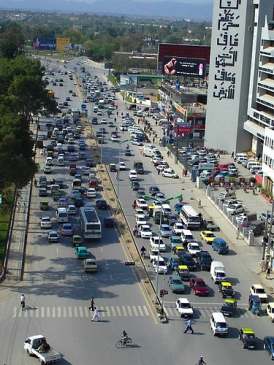 The bustling city of Rawalpindi has a lot more to offer than a traffic mess, broken roads and haze-filled atmosphere. The city’s history spreads over several millennia. Archaeologists believe that a distinct culture flourished on this plateau even 3,000 years ago.
The bustling city of Rawalpindi has a lot more to offer than a traffic mess, broken roads and haze-filled atmosphere. The city’s history spreads over several millennia. Archaeologists believe that a distinct culture flourished on this plateau even 3,000 years ago.
.. Photo to the left is a shot of the Mall, Rawalpindi ..
The archaeological remains found here prove the existence of a Buddhist community contemporary to Taxila, but less celebrated than its neighbour. Historians believe that the ancient city fell victim to the devastation caused by the Huns. The first Muslim invader, Mahmud of Ghazni (979-1030AD), gifted the ruined city to a Gakkhar chief, Kai Gohar. The Gakkhars were a fiercly independent tribe of the Potowar Plateau. The town, however, being in the route of invaders, could not prosper and remained deserted until Jhanda Khan, another Gakkhar chief, restored it and named it Rawalpindi after the village Rawal in 1493.
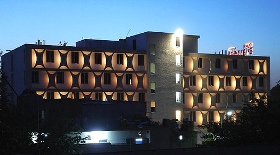 Rawalpindi remained under the rule of the Gakkhars till Muqarrab Khan, the last Gakkhar ruler, was defeated by the Sikhs in 1765.
Rawalpindi remained under the rule of the Gakkhars till Muqarrab Khan, the last Gakkhar ruler, was defeated by the Sikhs in 1765.
.. Photo to the right shows Hotel Shalimar, Rawalpindi ..
The Sikhs invited traders from other places to settle here, which brought the city into the limelight.
Following the British victory over the Sikhs and occupation of Rawalpindi in 1849, the city became a permanent garrison of the British army in 1851. 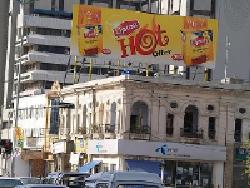 In the 1880s, a railway line to Rawalpindi was laid, and a train service started on January 1, 1886. The need for a railway link arose after Lord Dalhousie made Rawalpindi the headquarters of the Northern Command and the city became the largest military garrison in British India.
In the 1880s, a railway line to Rawalpindi was laid, and a train service started on January 1, 1886. The need for a railway link arose after Lord Dalhousie made Rawalpindi the headquarters of the Northern Command and the city became the largest military garrison in British India.
In 1951, Rawalpindi saw the murder of the first elected prime minister of Pakistan, Liaquat Ali Khan, in Company Bagh, later named after him. Today, Rawalpindi is the headquarters of the Pakistan Army and the Pakistan Air Force.
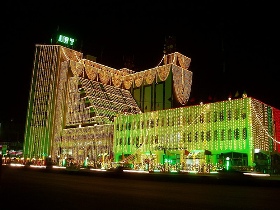 The modern city has everything that one can desire – good eateries, playgrounds and shopping centres. Though many shopping centres have opened all over the city, two main bazaars, Raja Bazaar in the old city and Saddar, which developed as the cantonment bazaar between the old city and the Mall, continue to attract a large number of visitors every day.
The modern city has everything that one can desire – good eateries, playgrounds and shopping centres. Though many shopping centres have opened all over the city, two main bazaars, Raja Bazaar in the old city and Saddar, which developed as the cantonment bazaar between the old city and the Mall, continue to attract a large number of visitors every day.
For a traditional Lahori breakfast, Banni or Purana Qila offers the best siri paiyay, nihari and chanay.
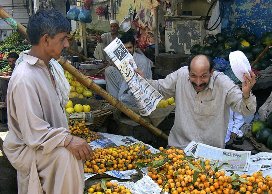 Commercial Market, off main Murree Road, is fast becoming the hub of business activity in the city and besides some good restaurants, one can shop here for quality clothes.
Commercial Market, off main Murree Road, is fast becoming the hub of business activity in the city and besides some good restaurants, one can shop here for quality clothes.
.. Photo to the left shows a merry fruit selles on a Rawalpindi street ..
The crowded alleys of the old city like Purana Qila, Bhabra Bazaar, Lal Kurti, Banni and inner areas of Saddar, are home to many attractions, including ancient Hindu and Sikh temples.
Some of the old houses in these areas, though dilapidated, are a tribute to the master artisans and masons of yesteryears. The beautiful construction and woodwork survive even today, despite the passage of over a century and the fact that no effort has been made by their current owners to preserve these buildings.
 Ayub National Park is located beyond the old Presidency on Jhelum Road, covering about 2,300 acres or 9.3 square kilometres, and has a lake with boating facility, an aquarium, a garden-restaurant and the Play Land.
Ayub National Park is located beyond the old Presidency on Jhelum Road, covering about 2,300 acres or 9.3 square kilometres, and has a lake with boating facility, an aquarium, a garden-restaurant and the Play Land.
.. Photo to the right shows an ancient building in the city called Qutub House ..
Rawalpindi Public Park, located on Murree Road near Shamsabad, was opened to public in 1991. It consists of the Play Land, grassy lawns, a jogging track, fountains and flowerbeds.
The cricket stadium, built in 1992 opposite the public park, has seen some of the world’s top cricket teams play one-dayers and test matches here.
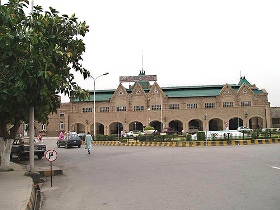 There are many forts and other places of tourist attraction a few kilometres outside the city limits.Rawat Fort is located 17 km east of Rawalpindi, on the Grand Trunk (GT) Road leading to Lahore. Gakkhars built the fort, in the early 16th century.
There are many forts and other places of tourist attraction a few kilometres outside the city limits.Rawat Fort is located 17 km east of Rawalpindi, on the Grand Trunk (GT) Road leading to Lahore. Gakkhars built the fort, in the early 16th century.
.. Photo to the left is the facade of Rawalpindi Railway Station ..
The grave of Gakkhar chief Sultan Sarang Khan is located inside the fort. He died in 1546 AD in a battle against the forces of Sher Shah Suri. Up from the broken steps inside the tomb, is a panoramic view of the plateau and the Mankiala Stupa.
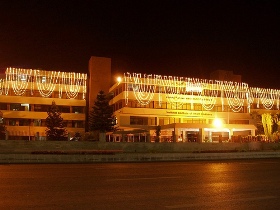 Pharwala Fort is about 40 km from Rawalpindi beyond Lehtrar Road. It is also a Gakkhar fort built in the 15th century on the ruins of a 10th century fort.Mughal emperor Babur conquered the fort in 1519 AD.
Pharwala Fort is about 40 km from Rawalpindi beyond Lehtrar Road. It is also a Gakkhar fort built in the 15th century on the ruins of a 10th century fort.Mughal emperor Babur conquered the fort in 1519 AD.
.. Photo to the right is the National Institute of Heart Diseases, Rawalpindi ..
In 1825, the Sikhs took over the fort. Though crumbling away, it is still an attraction for castle lovers and the artistic.
Rohtas Fort, a UNESCO world heritage site, is 109 km from Rawalpindi. 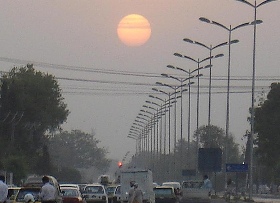 It is located about 6 km southwest of Dina.The fort is one of the most impressive historical monuments in Pakistan. It was built by Afghan ruler Sher Shah Suri between 1540 and 1547 AD. It served as Suri’s fortified base for military operations against the Gakkhars.
It is located about 6 km southwest of Dina.The fort is one of the most impressive historical monuments in Pakistan. It was built by Afghan ruler Sher Shah Suri between 1540 and 1547 AD. It served as Suri’s fortified base for military operations against the Gakkhars.
.. Photo to the left is a sunset view on Peshawar Road, Rawalpindi ..
It was later used by Mughal emperor Akbar and the Sikhs. Within the huge terraced rampart walls with robust bastions and twelve gates, is located another fortress, palaces and ancillary buildings.
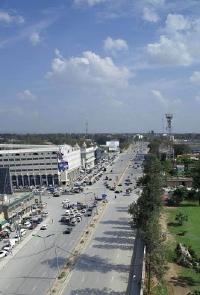 Rawalpindi also served as the interim capital after Islamabad was declared the nation’s new capital in the 1960s and was still being constructed. So the infrastructure was shifted to Rawalpindi from Karachi, the previous capital of Pakistan, and then was moved to Islamabad.
Rawalpindi also served as the interim capital after Islamabad was declared the nation’s new capital in the 1960s and was still being constructed. So the infrastructure was shifted to Rawalpindi from Karachi, the previous capital of Pakistan, and then was moved to Islamabad.
.. Photo to the right is the Mall, Rawalpindi, look east ..
PHOTO CREDITS: Photos for this article have been taken from flickr.com from an album set here. Clicking at individual photos in the article above will also take you to their source website and larger image sizes.



















































hiiiiiiiiiiiiiiiiiiiiiiiiiiiiiiiiiii
i m shani from jhelum
can u friendship me
my mobile number i s03455738714
03456018761
No matter where I am, a part of me is always in Rawalpindi. This is where I was born and this is where I would like to be laid to rest.
Its been a while since I went back home, but the pictures on the web site definately took me back as these photographs, most of them, are from the are where I lived till our home was canivingly taken away from us by the corrupt Ex Chief Justice of Pakistan Iftikhar Chaudhry. May he rot in hell for what he put me and my family through, specially my old father.
He is already paying for his evil deeds and Insha Allah he will always never get back that seat again.
I am sorry I got carried away but you can not imagine how it feels when something that is yours is taken away from you on the basis of forged documents and in the presence of evidence. I am glad I am out of Pakistan, a land with no justice and where judges and lawyers can be bought and sold easily.
But the fact remians, I love Rawalpindi and I always will.
I had a bout of nostalgia and that was when I started to see things I had almost forgotten. Rawalpindi was perhaps not in the fore-front of my loves but certainly there and thereabouts. On the subject of changing facets of the city I somewhere else complained that it refused to recognised me about half a century on. It may be the case. Perhaps it was not the city who refused to recognise me, it was I who refused to recognise the city. Rawalpindi will always be there like the army of Alexander the Grreat which passed through Rawal. I am sure I read this on a plaque during one of my visit to Rawal river or to be exact Rawal water fall (man made). No I don’t call it playing truant. We now consider it a lesson in history.
Living in Rawalpindi/Islamabad for long, I always had the impression that it was an old city, yet never had the slightest of hint that it could be millenia old, to the times of the Buddhist traditions in this region. An information article yet one fails to understand why it couldn’t carry on the traditions of the past to the modern age? Was it because it never was too big a city like Lahore or was it because it never was the capital of any major empire?
Spend a lot of time outside in the world . . .
but actually the world people say for lahore is for Rawalpindi
pindi pindi ay ! ! !
Love tht place . awsome place than any in the whole world
Allah apni aman main rakhain hamary mulk ko !
Aamen